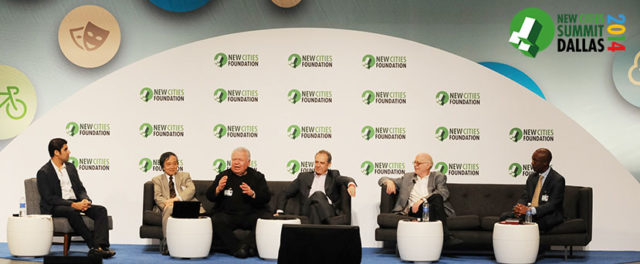Transforming the 21st Century Metropolis
September 9, 2014 — Blog
This post is part of our Re-imagining Cities discussion series, following the third edition of the NewCities Summit in Dallas in June 2014.
In this opening session, the panelists did not shy away from squaring the dream of re-imagining a city with the “hard choices” of what that transformation would require.
Jaime Lerner vigorously urged his fellow panelists to understand the difference between “needs” and “dreams” for a city, emphasizing: “A city has no future if it lacks dreams.” He warned the panel about the pitfalls of ghettoization in future cities, according to income, age, and other possible divisions. To highlight this notion, he used the metaphor of a turtle, whose solid structure represents the city and its different parts living, working and moving together. If the shell is cut and fragmented, the turtle will die. This was a powerful way of emphasizing that ghettoization is the primary enemy of a thriving city.
It is at the city level where mayors and citizens come together, where public policy actually has an impact on people’s wellbeing – Arturo Sarukhan
Arturo Sarukhan made no bones about the effective reality of cities circumventing various federal authorities in order to get results efficiently. “Federal governments and federal policies are becoming dysfunctional,” Sarukhan declared. “It is at the city level where mayors and citizens come together, where public policy actually has an impact on people’s wellbeing.” Sarukhan then made a time-travelling analogy to the power and influence of city-states during the late Middle Ages and Renaissance. “The new mantra out there among cities – from Dallas to Shanghai – is to solve locally and cooperate globally,” Sarukhan added.
Yet hope for cooperation was also countered by concerns regarding the increasing gulf between rich and poor seen in so many urban settings. “A certain level of urban growth has become inextricably linked with a level of inequality – meaning that something good and bad is happening at the same time,” pointed out Richard Sennett. “Growth, especially in a city, doesn’t necessarily imply wellbeing or an increase in the quality of life.” Sennett also addressed climate change and how cities should be flexible enough in their master planning to take into account the possibility of a catastrophic natural event, such as the tsunami of several years ago, in order to adjust how and where they build.
Access to technology doesn’t necessarily mean equitable access to all the amenities a city must provide – Mpho Franklyn Parks Tau
If anyone can attest to cities as occasionally being incubators of a highly visible inequality, it would be Mpho Franklyn Parks Tau, Mayor of Johannesburg. In no uncertain terms, he said that Johannesburg was historically beset with the problem of too much poverty, and for many, a lack of access to the most basic of urban amenities such as electricity or sanitation. Tau cautioned: “Access to technology doesn’t necessarily mean equitable access to all the amenities a city must provide.” Tau argued that for the 21st century city, it is most vital to integrate various urban communities by increasing the intensity of land use. For Tau, so much of the future boils down to increased access to all that a city provides.

Speakers
- Hiroo Ichikawa, Executive Director, Mori Memorial Foundation
- Jaime Lerner, Former Mayor, Curitiba and Former Governor, Parana, Brazil – @JaimeLerner
- Arturo Sarukhan, Former Mexican Ambassador to the United States – @Arturo_Sarukhan
- Richard Sennett, Centennial Professor of Sociology, London School of Economics and University Professor of the Humanities, New York University – @richardsennett
- Mpho Franklyn Parks Tau, Mayor, Johannesburg
Moderator: Parag Khanna, Managing Partner, Hybrid Reality – @paragkhanna
